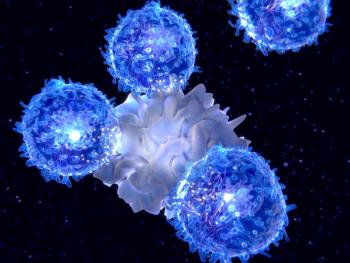
Cancer Management Chapter 25: Carcinoma of an unknown primary site
Carcinoma of an unknown primary site is a common clinical syndrome, accounting for approximately 3% of all oncologic diagnoses. Patients in this group are heterogeneous, having a wide variety of clinical presentations and pathologic findings. A patient should be considered to have carcinoma of an unknown primary site when a tumor is detected at one or more metastatic sites, and routine evaluation (see below) fails to define a primary tumor site.
Carcinoma of an unknown primary site is a common clinical syndrome, accounting for approximately 3% of all oncologic diagnoses. Patients in this group are heterogeneous, having a wide variety of clinical presentations and pathologic findings. A patient should be considered to have carcinoma of an unknown primary site when a tumor is detected at one or more metastatic sites, and routine evaluation (see below) fails to define a primary tumor site.
Although all patients with cancer of an unknown primary site have advanced, metastatic disease, universal pessimism and nihilism regarding treatment are inappropriate. Subsets of patients with specific treatment implications can be defined using clinical and pathologic features. In addition, trials of empiric chemotherapeutic regimens incorporating new antineoplastic agents have suggested improved response rates and survival in unselected groups of patients with carcinoma of an unknown primary site.
Epidemiology
Gender
Unknown primary cancer occurs with approximately equal frequency in men and women and has the same prognosis in the two genders.
Age
As with most epithelial cancers, the incidence of unknown primary cancer increases with advancing age, although a wide age range exists. Some evidence suggests that younger patients are more likely to have poorly differentiated histologies.
Disease sites
Autopsy series performed prior to the availability of CT resulted in the identification of a primary site in 70% to 80% of patients. Above the diaphragm, the lungs were the most common primary site, whereas various gastrointestinal (GI) sites (pancreas, colon, stomach, liver) were most common below the diaphragm. Several frequently occurring cancers, particularly those of the breast and prostate, were rarely identified in autopsy series.
With improved radiologic diagnosis, the spectrum of unknown primary cancer has probably changed. Limited recent autopsy data suggest a lower percentage of primary sites identified, particularly in patients with poorly differentiated histology.
Signs and symptoms
Patients with unknown primary cancer usually present with symptoms related to the areas of metastatic tumor involvement.
Site of metastatic involvement
Site of metastatic involvement include the lungs, liver, and skeletal system; therefore, symptoms referable to these areas are common.
Symptoms and physical findings
Constitutional symptoms, such as anorexia, weight loss, weakness, and fatigue are common.
Pathologic evaluation
Optimal pathologic evaluation is critical in the evaluation of patients with carcinoma of an unknown primary site and can aid with the following:
• distinguishing carcinoma from other cancer types,
• determining histologic type,
• identifying the primary site,
• identifying specific characteristics that may direct specific treatments.
Initial approach
Although cytologic evaluation, including fine-needle aspiration biopsy, can often determine whether a lesion is malignant, a tissue biopsy will probably be needed to further evaluate the neoplasm. Tissue is required for paraffin-section immunohistochemistry, which is currently the usual methodology of choice in the work-up. Immunohistochemical methods can reliably distinguish carcinoma from other neoplasms, and can sometimes suggest a specific primary site when interpreted in conjunction with clinical features. Gene expression profile studies show promise as an additional tool in determining the tissue of origin, although more experience in the clinical setting is needed to determine how valuable this technology will be in practice. Electron microscopy, which optimally requires glutaraldehyde fixation, is usually no longer required.
Carcinoma versus other neoplasms
It is important to rule out the possibility of malignant lymphoma, malignant melanoma, and sarcoma.
A battery of antibodies is utilized in an attempt to distinguish carcinoma from other types of neoplasms, as summarized in
Determination of histologic type
There may be clues on initial histologic examination. For example, the presence of gland formation or mucin production would indicate an adenocarcinoma, whereas the presence of keratinization would indicate a squamous cell carcinoma. Evidence of neuroendocrine differentiation may be suggested by the presence of a characteristic, relatively fine chromatin pattern. Immunohistochemistry can also be of use, as expression of keratin subtypes 7 and 20 would favor adenocarcinoma, and expression of keratin subtypes 5/6 and 14 would favor squamous cell carcinoma. Reliable neuroendocrine markers include chromogranin A and synaptophysin.
Determination of primary site in metastatic adenocarcinoma
Unfortunately, immunohistochemical staining does not usually identify the primary site in patients with adenocarcinoma of unknown primary site. Useful stains are listed in
Identification of specific treatment target characteristics
Even if the primary site is not determined, characteristics of the carcinoma may suggest specific treatment options or impart prognostic information. Examples of the former may include determination of estrogen or progesterone receptors or expression of members of the epidermal growth factor receptor family (eg, HER2/neu). Examples of the latter may include Ki-67, which is a surrogate marker of the proliferation rate of a neoplasm.
Molecular genetic tumor profiling
Specific gene expression profiles based on the tissue of origin have been identified for many tumor types. Several assays using either quantitative reverse transcriptase polymerase chain reaction or gene microarray techniques are now available; they can be performed on tumor tissue from formalin-fixed, paraffin-embedded biopsy specimens. In tumors of a known primary, these assays can correctly identify the tissue of origin in over 85% of metastases; in unknown primary cancers, they yield diagnoses that are usually compatible with clinical features and response to empiric treatment. Ongoing trials are evaluating the use of molecular genetic assay results to direct therapy in patients with unknown primary cancers. Although information is still incomplete, it is likely that gene expression profiling will be a valuable addition to the diagnosis and management of patients with these malignancies.
Clinical evaluation
After a biopsy has established metastatic carcinoma, a relatively limited clinical evaluation is indicated to search for a primary site. Recommended evaluation includes a complete history, physical examination, chemistry profile, CBC, chest radiograph, and CT scan of the abdomen.
Symptomatic areas
Specific radiologic and/or endoscopic evaluation of symptomatic areas should be pursued. In addition, mammography, ultrasonography, and breast MRI should be performed in women with clinical features suggestive of metastatic breast cancer (eg, estrogen receptor-positive tumor and/or specific metastatic involvement including axillary nodes, bones, or pleura), and serum prostate-specific antigen (PSA) level should be measured in men with features suggestive of prostate cancer (eg, blastic bone metastasis). In young men with poorly differentiated carcinoma, serum human chorionic gonadotropin (hCG) and alpha-fetoprotein (AFP) levels should always be measured.
Asymptomatic areas
In general, radiologic or endoscopic evaluation of asymptomatic areas is not productive and should be avoided. An exception is positron emission tomography (PET) scanning, which detects a primary site in almost 40% of cases and frequently changes the approach to treatment. The PET scan is now considered a standard part of the initial evaluation of patients with carcinoma of an unknown primary site.
Cervical lymphadenopathy
Metastatic squamous carcinoma in cervical lymph nodes usually involves upper or mid-cervical locations. All patients should undergo a thorough search for a primary site in the head and neck region, including direct endoscopic examination of the oropharynx, hypopharynx, nasopharynx, larynx, and upper esophagus. Any suspicious areas should be biopsied. Fiberoptic bronchoscopy should be considered in patients with involvement of low cervical or supraclavicular nodes. This type of evaluation will identify a primary site, usually in the head and neck, in 85% to 90% of these patients. Further evaluation with PET scanning can identify a primary site in 15% to 30% of the remaining patients and should be considered. Low cervical adenopathy (level IV, supraclavicular) may also represent an upper GI primary.
Inguinal lymphadenopathy
Patients with metastatic squamous cell cancer presenting in inguinal lymph nodes almost always have an identifiable primary site in the perineal area. Women should undergo careful examination of the vulva, vagina, and cervix; men should have careful inspection of the penis. Anoscopy should be performed to exclude lesions in the anorectal area.
Treatment
Adenocarcinoma
When evaluating patients with adenocarcinoma of an unknown primary site, several clinical subsets should be identified and treated specifically. Empiric therapy for patients not included in any of these subsets is outlined in the final section of this chapter.
Women with isolated axillary adenopathy Treatment appropriate for stage II breast cancer should be administered. Mastectomy reveals an occult primary cancer in 50% to 60% of these patients, even when physical examination and mammography are normal. Axillary dissection with breast irradiation is also a reasonable treatment, although there are no definitive comparisons of this approach versus mastectomy. Adjuvant systemic therapy, following standard guidelines for stage II breast cancer, is also indicated.
Women with peritoneal carcinomatosis Often, the histopathology in these patients suggests ovarian cancer (ie, serous cystadenocarcinoma or papillary adenocarcinoma). However, all women with this syndrome should be treated as if they had stage III ovarian cancer. Initial cytoreductive surgery should be followed by chemotherapy with a taxane/platinum combination, as recommended for advanced ovarian cancer. In these patients, serum CA-125 can often be used as a tumor marker.
Men with bone metastasis Metastatic prostate cancer should be suspected and usually can be diagnosed with either an elevated serum PSA level or positive tumor staining for PSA. In such patients, androgen deprivation therapy, as recommended for advanced prostate cancer, is often of palliative benefit.
Patients with a colon cancer “profile” Treatment with modern regimens for advanced colon cancer (eg, fluorouracil/leucovorin/oxaliplatin [Eloxatin]; FOLFOX/bevacizumab [Avastin]) should be considered for patients with a metastatic pattern (liver with or without peritoneal involvement) and pathologic findings (adenocarcinoma, CK20+/CK7–) strongly suggestive of metastatic colorectal cancer. Although clinical data to support this recommendation are still developing, the improved efficacy of advanced colon cancer regimens (versus the taxane/platinum regimens used empirically for carcinoma of an unknown primary site) provides a strong rationale.
Patients with a single metastatic site Surgical resection or radiation therapy should be administered to patients who present with clinical evidence of a single metastasis. Prior to proceeding with local therapy in these patients, PET scanning should be considered to rule out additional metastatic sites. Some of these patients have prolonged survival after local therapy, particularly those who present with a sole metastasis in an isolated peripheral lymph node group. The role of “adjuvant” systemic therapy is undetermined in these patients.
Squamous cell carcinoma
Squamous cell cancer accounts for only 10% of light microscopic diagnoses in patients with unknown primary cancer. Isolated cervical adenopathy is the most common presentation for squamous cell carcinoma of an unknown primary site; other patients have isolated inguinal adenopathy at presentation. Specific management is essential for both of these subgroups, since both have the potential for long-term survival following treatment.
Patients with cervical lymphadenopathy in whom no primary site is identified should be treated as if they had a primary site in the head and neck. Concurrent treatment with chemotherapy and radiation therapy has recently proved superior to local treatment alone and to these treatment modalities used sequentially. Radiation therapy doses and techniques should be identical to those used in treating patients with known head and neck primaries. In addition to the involved neck, the nasopharynx, oropharynx, and hypopharynx should be included in the radiation field. Radical neck dissection should be considered in patients who have any evidence of residual cancer following combined-modality therapy.
Five-year survival rates with combined-modality therapy are 60% to 70% and appear superior to results with local modalities alone (30% to 50%). The extent of cervical lymph node involvement is the most important prognostic factor. (For additional discussion, see “Unknown head and neck primary site” in chapter 1 on “Head and Neck Tumors.”)
Patients with inguinal lymphadenopathy Identification of a primary site in the perineal area is important in patients with inguinal lymphadenopathy, as curative therapy is available for some patients, even after metastasis to inguinal lymph nodes. In the uncommon patient for whom no primary site is identified, inguinal node dissection, with or without radiation therapy, can result in long-term survival. Although limited data exist on this uncommon subgroup, the demonstrated superiority of combined-modality therapy versus local treatment alone for primary squamous cell cancers in the perineal area (eg, cervix, anus) has led to a suggestion that the addition of platinum-based chemotherapy may improve treatment results.
Poorly differentiated carcinoma
This heterogeneous group includes a minority of patients with highly responsive neoplasms and therefore requires special attention in initial clinical and pathologic evaluations. Specialized pathologic techniques can identify some patients with tumor types known to be treatable; these patients should be treated using standard guidelines for the appropriate tumor type.
In the remaining patients, several investigators have documented an increased responsiveness to platinum-based chemotherapy when compared with patients with adenocarcinoma of an unknown primary site. In addition, several series have described a small cohort of long-term survivors following platinum-based treatment. Patients with poorly differentiated adenocarcinoma have usually been included in this group when making treatment decisions. Although most patients in this group should receive an empiric trial of treatment, several specific subsets can be recognized.
Men with extragonadal germ-cell cancer syndrome Young men with a predominant tumor location in the mediastinum and retroperitoneum and/or high levels of serum hCG or AFP should be treated as if they had a poor prognosis germ-cell tumor (ie, four courses of chemotherapy with cisplatin/etoposide/bleomycin, followed by surgical resection of residual radiographic abnormalities).
Molecular genetic analysis can identify an i(12p) chromosomal abnormality diagnostic of a germ-cell tumor in some of these patients, even when the diagnosis cannot be made by any other pathologic evaluation. Patients with germ-cell tumors diagnosed in this manner have been shown to be as responsive to treatment as patients with extragonadal germ-cell tumors of typical histology.
Patients with poorly differentiated neuroendocrine carcinoma With the improved immunoperoxidase stains now available, neuroendocrine features are recognized more frequently in patients with poorly differentiated carcinoma. These tumors are distinct in biology and therapeutic implications from well-differentiated neuroendocrine tumors (eg, carcinoid tumors, islet-cell tumors) of an unknown primary site, which almost always present with multiple liver metastases. In contrast to typical carcinoid tumors, poorly differentiated neuroendocrine tumors are difficult to recognize by light microscopic examination alone, although some of the latter tumors have neuroendocrine or “small-cell” features.
Patients with poorly differentiated neuroendocrine carcinoma of an unknown primary site should receive a trial of chemotherapy with a regimen containing a platinum and etoposide. In a group of 51 such patients, the complete response rate was 28% following treatment with cisplatin and etoposide, with or without bleomycin; the overall response rate was 71%. Eight patients (16%) had durable complete remissions.
The combination of paclitaxel, carboplatin (Paraplatin), and etoposide is also highly active in the treatment of poorly differentiated neuroendocrine tumors (response rate, 53%; 2-year survival, 33%). However, the addition of paclitaxel increases myelosuppression and is not clearly superior to platinum/etoposide therapy.
Although the identity of most poorly differentiated neuroendocrine tumors remains unknown, this group of chemotherapy-responsive patients can be reliably identified using specialized, but widely available, pathologic evaluation.
Other patients with poorly differentiated carcinoma Most patients with poorly differentiated carcinoma do not have neuroendocrine features or clinical features of germ-cell tumor. Patients in this group should receive an empiric trial of chemotherapy, unless an extremely poor performance status precludes this possibility. In a group of 220 such patients treated with cisplatin-based regimens effective for germ-cell tumor at a single institution, the overall response rate was 64%, with 27% complete responses. Median survival of this group was 20 months, and 13% of patients have been disease-free for more than 8 years and are considered cured. Although the young median age of 39 years indicates that this was a select patient group, the extreme chemosensitivity of some patients in this large, heterogeneous group is clearly demonstrated.
Empiric chemotherapy - adenocarcinoma - non-specific subgroup
Systemic therapy for patients not included in any specific treatable subgroup has been difficult. Unfortunately, this group includes the majority of patients with adenocarcinoma of an unknown primary site; some patients with poorly differentiated carcinoma and no “favorable” clinical features also respond poorly to current therapy.
‘Old’ regimens
Most patients in these trials had adenocarcinoma, but 5% to 10% had poorly differentiated carcinoma. Regimens initially evaluated included historic regimens for GI malignancy and breast cancer, as well as various cisplatin-based regimens. Most of these regimens have produced response rates of 20% to 35% and median survival durations of 5 to 8 months. There is little evidence of prolongation of median survival or long-term complete remission with any of these regimens, and none is considered “standard treatment” in this group of patients.
Regimens incorporating newer cytotoxic agents The taxanes, gemcitabine (Gemzar), and the topoisomerase I inhibitors are all broad-spectrum cytotoxic agents with potential efficacy in the treatment of an unknown primary cancer. Most experience to date has been with taxane/platinum-based regimens. Results of phase II trials suggest higher response rates and longer median survivals along with a moderate decrease in toxicity with these regimens versus previous cisplatin-based regimens (
Targeted agents have undergone limited evaluation in patients with carcinoma of an unknown primary site. In a phase II trial, the combination of bevacizumab/erlotinib (Tarceva) showed activity in a group of previously treated patients (objective response or stable, 71%; 1-year survival, 33%). Recently, a phase II trial of first-line paclitaxel/carboplatin/bevacizumab/erlotinib produced a 53% response rate, and median progression-free and overall survivals of 8 and 13 months, respectively. Further evaluation of targeted agents is ongoing.
At present, paclitaxel/carboplatin, with or without etoposide, should be considered for empiric therapy for patients with adenocarcinoma of an unknown primary site and a good performance status.
References:
SUGGESTED READING
Anderson, GG, Weiss L: Determining tissue of origin for metastatic cancers. Appl Immunohistochem Mol Morphol Jun 22, 2009 [Epub ahead of print].
Greco FA, Hainsworth JD: Introduction: Unknown primary cancer. Semin Oncol 36:6â7, 2009.
Hainsworth JD, Spigel DR, Farley C, et al: Phase II trial of bevacizumab and erlotinib in carcinomas of unknown primary site: The Minnie Pearl Cancer Research Network. J Clin Oncol 25:1747â1752, 2007.
Hainsworth JD, Spigel DR, Litchy S, et al: Phase II trial of paclitaxel, carboplatin, and etoposide in advanced poorly differentiated neuroendocrine carcinoma: A Minnie Pearl Cancer Research Network study. J Clin Oncol 24:3548â3554, 2006.
Horlings HM, van Laar RK, Kerst JM, et al: Gene expression profiling to identify the histogenetic origin of metastatic adenocarcinomas of unknown primary. J Clin Oncol 26:4435â4441, 2008.
Monzon FA, Lyons-Weiler M, Buturovic LJ, et al: Multicenter validation of a 1,550-geneexpression profile for identification of tumor tissue of origin. J Clin Oncol 27:2503â2508, 2009.
Park SY, Yim BH, Kim JH, et al: Panels of immunohistochemical markers help determine primary sites of metastatic adenocarcinoma. Arch Pathol Lab Med 131:1561â1567, 2007.
Seve P, Billotey C, Brousolle C, et al: The role of 2-deoxy-2-[F-18]fluoro-D-glucose positron emission tomography in disseminated carcinoma of unknown primary site. Cancer 109:292â299, 2007.
Varadhachary GR, Talantov D, Raber MN, et al: Molecular profiling of carcinoma of unknown primary and correlation with clinical evaluation. J Clin Oncol 26:4442â4448, 2008.
Newsletter
Stay up to date on recent advances in the multidisciplinary approach to cancer.























































































